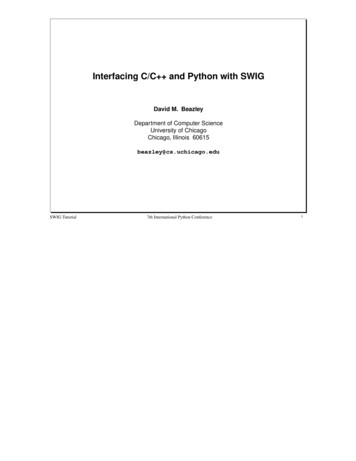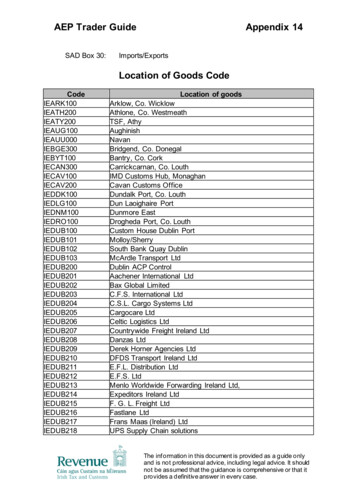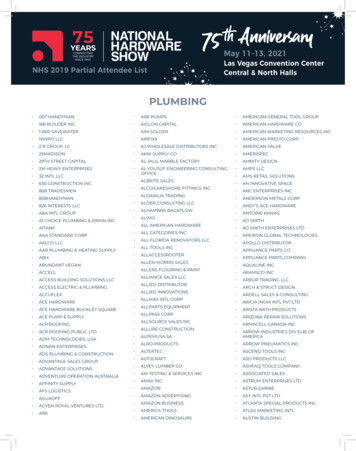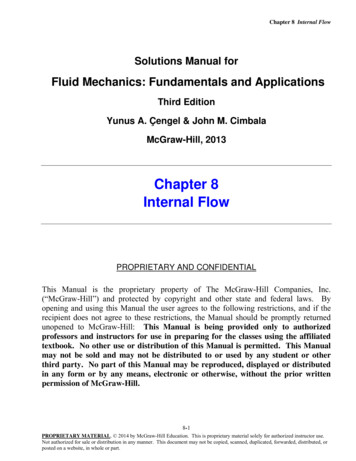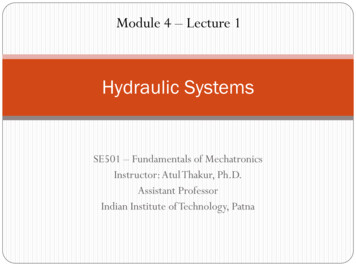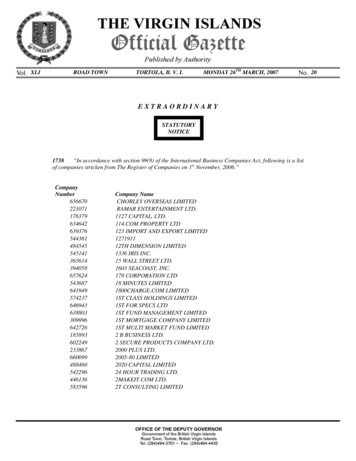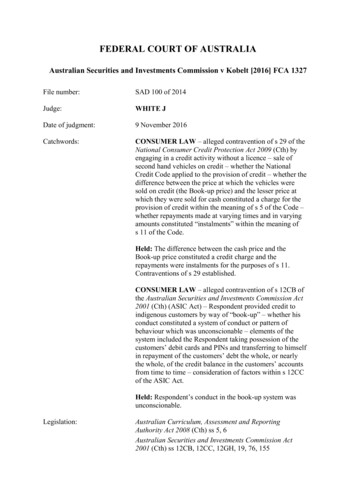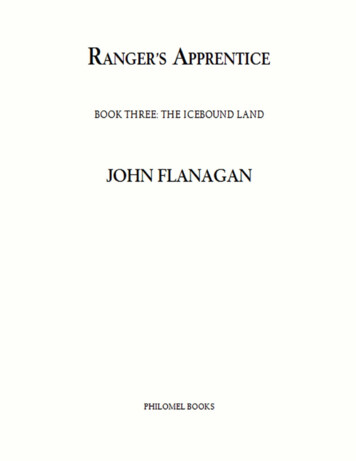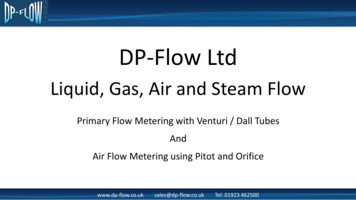
Transcription
DP-Flow LtdLiquid, Gas, Air and Steam FlowPrimary Flow Metering with Venturi / Dall TubesAndAir Flow Metering using Pitot and Orificewww.dp-flow.co.uksales@dp-flow.co.ukTel: 01923 462500
DP Flow – A Brief Introduction We are a process instrumentation company that focus on d/p meteringtechnology, whilst offering Flow, Pressure, Level, Temperature Inst. and VP’s. We perceive a declining skill base in the UK process sector, we aim to fill the gap Huge installed user base of primary metering technology in O&G Large range of solutions where migration to other technologies are not possible We additionally offer software products for engineering design including sizingvalves, actuators, d/p elements, pipe sizing including pressure loss / span / surge.Additionally we offer d/p condition based monitoring systems.
What styles of primary devices?Orifice plate
What styles of primary devices?PITOBARClassical venturi tube
New styles of primary devices are available, aswell as the more traditional products There is world wide acceptance of the governing standards The transmitters are easy to calibrate Excellent repeatability Broad application range Proven reliability and stability Reduced installation of pipework Simplified installation and reduced time on site reducing the overall costs.
Measuring Principle1. Based on Bernoulli s equation ofbalance of energy.2. A circular pipe fully contained withfluid.3. Single phase fluid – slow changes inflow rate (non pulsating).4. Restriction.
How do they Work?All primaries work essentially from thefollowing equation 𝐶𝑑𝜋𝑑2𝑞𝑚 . 𝜀. (2. 𝑑𝑝. 𝜌)41 𝛽4Cd discharge coefficientβ d/Dd throatD pipe boreε Expansion factor (1 for liquids)π 3.142xxxdp diff pressureρ operating density
Calculations - StandardsStandards - ISO 5167-2003 - Calculation standards - ISO 5167-1C discharge coefficient (depends on element type)E inlet/velocity coefficient (diameters)ε expansion coefficient (gases, liquids)American standardsASME MFC-3MC Q d 2 2 P 1E4
Construction StandardsISO 5167-2 – orifice platesISO 5167-3 - nozzles, venturi nozzlesISO 5167-4 - classical venturi tubesDIN 19205 – meter runs, pressure tappingsDIN 19206 – orifice plates between flangesDIN 19211 – condensing chambersDIN 19214 – orifice plates, orifice flangesDIN 19215 – weld in –orifice plates and –venturi nozzles (expired 2006)ASME PTC 6 - performance test code – steam turbinesISO/TR 15377 - orifices, nozzles and venturi tubes – amendment to ISO 5167VDI 2041 – orifice plates - amendment to ISO 5167BS 1042 - English standard for orifices, nozzles and venturi
Fluids StandardsProperties of water and steam in SI units- steam tableASME (NBS/NRC) steam equation- steam tableIAPWS-IF97- steam tableVDI 2040- thermodynamic valuesAGA no.3- natural gas more
Decommissioned ‘Primary Devices’,Are they an Asset, Liability, Or a FlowMeasurement Opportunity?And .Air flow metering using Pitot / Orificein waste water applications
Venturi and Dall Tubes Dall Tube – FlindreUnder roads/trunk mainsPipe BoreThroat Remote Sites Can we liberate more data? What about strategic capability? What about back up metering?Flooding, DMZ meter failure, catastrophic event
Where are they?Venturi Tube – B.W.V.P.S.Populated, limited options of removal / replacement, Large population cut off during works,and traffic disruption
How can they be re-instated ?Venturi /Dall Tube – B.W.V.P.S.Service impulse lines, use large bore 10-12 mm,keep short, install service valve set,use vents, drains, bleeds. Use smart high performance transmitters.
Dall Tube – S.W.C.V.What skills do we need?Piping -Installation, pressure testing, standards. Flow Knowledge – straight lengths, (Low flow can have D’s)
Measuring Accuracya. Uncertainty of primary element.Orifice PlatesD : 50 – 1000 mm d 12.5 mm0,2 ß 0,60,5 %0,6 ß 0,75 (1.667xß –0,5) %b. Installation.c. Uncertainty due to the fluid.d. Uncertainty of secondary elements.ISA 1932 nozzleD : 50 – 500 mm0,3 ß 0,60,8 %0,6 ß 0,8Long radius nozzle, high ßD : 50 – 630 mm0,2 ß 0,82%Venturi nozzleD : 65 – 500 mm, d 50 mm0,316 ß 0,775(1,2 1,5xß4) %(2xß –0,4) %
Venturi TubesOrifice plates(1,667xß –0,5) %Classical venturi tube - as castD : 100 – 800 mm0,3 ß 0,750,7 %(2xß –0,4) %Classical venturi tube - machined typeD : 50 – 250 mm0,4 ß 0,751,0 %D : 50 – 1000 mm, d 12,5 mm0,2 ß 0,60,5 %ISA 1932 nozzleD : 50 – 500 mm0,3 ß 0,60,8 %0,6 ß 0,750,6 ß 0,8Long radius nozzle, high ßD : 50 – 630 mm0,2 ß 0,82%Classical venturi tube - welded sheet typeD : 200 – 1200 mm0,4 ß 0,71,5 %Venturi nozzleD : 65 – 500 mm, d 50 mm0,316 ß 0,775(1,2 1,5xß4) %Averaging Pitot tubeD : 50 – 6000 mm 1 %
In Conclusion Venturi Tubes - It’s yourasset . They can be reinstated to liberate data The benefit is the asset is already in place The incentives are:- Low capital outlay, new high performancetransmitters increase turndown and reduce error, low overall ‘effort’for new data from an existing installation
Air Flow Metering In Waste Water ApplicationsHow can d/p meters help with your air flow metering? Low cost products Low cost installations Competitive in performance, easy to install and have shortturnaround / site based calibration and inspection capability, allcovered by standards
Orifice PlatesWeld in – type MESCompact and multi hole stylesFor insertion between flangesCorner tapping - type MEFFor insertion between flangesFlange tapping – type ISB/1
Orifice Flanges and Orifice CarriersISB/2MEF/2
Pitot Tubes
Advantages and Disadvantages Pitot Tubes - Insertion and Hot Tap metering Orifice plates - Process optimised with improved performance and low flow capability. Orifice plates sized to suit the pipe size negating the need for reducer / pipe run combinations Maintained performance for existing pipe sizes
Multi-hole flow conditioning orifice platesNon standardizedflow metersEPSILON flow meter1-5 D inlets for0.2-0.6 Betas
Extensive development of differentialpressure transmittersMultivariable differential pressure transmitters formass flow measurement Measure differential pressure, static pressure and has an input from atemperature sensor Built in flow computer with fluid density tables Dynamic discharge coefficient correction Transmitters with 0.075% Span Error Of reading accuracy now becoming available
Installation Pipe Run Geometry of pipe Roughness Fluid Pressure Temperature Viscosity Composition at mixed fluids Choice of steam table Reynolds NumberSecondary InstrumentationAccuracy of differential pressure transmitter:0,075 % of calibrated span!- or is it of measured differential pressure?Nøjagtighed vs. FlowNøjagtighed ow %The curve shows accuracy of orifice plate transmitter,Where the accuracy of the transmitter is expresseda percentage of calibrated span.
Measuring RangeA statement still often heard:” An orifice plate has a range of 4 : 1”According to ISO 5167-2 an orifice plate has a range specified by the relationship between :min. and max. Reynolds Number I. e.: 10.000 Re 108 10.000 : 1In the past the analogue transmitters had an accuracy of 0,5% of calibrated range (22% @ 100:1)Today : with an accurate transmitter/multivariable transmitter Flow Range 10 : 1 – or betterIf larger range is required; use 2 transmittersFirst transmitter 10 – 100% ( 4% on flow @ 10%)Second transmitter 1 – 12%
Cost of Air / Compressors Installation Maintenance Capital Cost Energy costs Source – The Carbon Trust GPG 385, DoE GPG 126InstallationMaintenanceCapital CostEnergy Costs
Advantages of d/p metering Capital Cost Installation Cost Operating Cost? High or Low? Do we have an unreasonable expectation of running cost?
Advantages of d/p metering Capital cost includes the primary and transmitter Approximate primary costsSizeTab Handled PlateCompact OrificeMulti-Hole Orifice4” 200 750 96012” 300 1780 2260
Advantages of d/p meteringAir Flow, 12” line 2400 kg/h max, 1500 kg/h operating @ 1 Bar G and 50 CPipe sizeQ minQ nomQ maxTurn down Qmax to minVelocity @ Qmax12”?15002400?4.7 m/sMeter type –12” Vortex10203x QminRecommended?No845002.5:14.7 m/sMeter type8” Vortex4603x QminRecommended?Yes38000 5.2:110.5 m/s2 days 2KCosts / TimeInstallationMeter 2.9K
Advantages of d/p meteringUnrecoverable Pressure Loss – Energy ConsumptionLoss Location @ QmaxLosses in mbarAcross the meter2.00Across the 2m pipe reduction2.50Across the reducer0.32Total4.82
Advantages of d/p metering What about an orifice plate? For the same flow rate and same pipe beta ratio, i.e. 12” pipe and 8” orificebore – so a process optimised flow meter .Loss Location @ QmaxLosses in mbard/p generated across the meter (Corner tap)3.6(N.B. Not losses! But d/p!)Unrecoverable loss across the meter2.0Total2.0
Advantages of d/p meteringCosts:Loss Location @ QmaxLosses in mbard/p generated across the meter (Corner tap)3.6(N.B. Not losses! But d/p!)Unrecoverable loss across the meter2.0Costs12” Compact Orifice transmitter 2900Installation ( 1/2 day) 500Cap Ex and Op Ex. BudgetLower than vortex and easier install (107 yr PB)
Advantages of d/p metering How can we improve the installation? No pressure pipework to install, as it’s a compact orifice Reduce the beta to match the unrecoverable loss of the vortex meter,enabling multi-hole orifice plates – Now we can have a 5D inlet d/p increases to 6.8 mbar (unrecoverable loss matches the 8” vortexinstallation @ 4.8 mbar), and so increases the available turndown Minimum measurable flow decreases below the range of the vortexmeter to 290 kg/h so is optimised to the process and pipework
Advantages of d/p metering Now have conditioning plates available for short inlet lengths of pipe(1-5D) Process optimised for the existing pipework and process conditions Can be calibrated quickly onsite (Or offsite on a 1-2 week turnaround) Primaries inspected to standards / manufacturers drawings Low cost, no flow calibrations required Non manufacturer calibration and verification
Advantages of d/p metering Accuracies:- Pitot 1% Orifice from 0.7% Venturi from 0.7-1.5% Transmitters – 0.075% and better – Of reading accuracy is on its wayand is being optimised for lower d/p’s T&P corrected affordable MV’s include dynamic Cd correction
Advantages of d/p metering Generic Thermal Mass Comparison – Single Point TMFMTyp. 1.5% of reading 10-100% URL ( 5.5-55 NMPS) 0.15%*URL for lower flows:. @ 0.5AMPS (290 kg/h) 1 NMPS 8% error Can we match the error?Cd error for an orifice sized at 1500 kg/h 2.5%Error on d/p 2.5%Error on flow 3.6%If we use an MV, we can reduce the error further due to corrected Cd.
Advantages of d/p meteringPoints to note:- Its not a single point device You can use a multi-hole orifice or multi-point pitot You can calibrate on site using local calibration companies at a time tosuit you – enabling verifications
Advantages of d/p meteringCosts of metering:Energy costs @ 11 ppkWh(Payback on installation 100 years @ 1500 savings)Based on 25 mbar(most sized well below this d/p)4-20mAOrifice / Multi Hole 30.00 ( 5- 6 @ 4.8 mbar) 0.30Pitot 6.00 0.30Mag meter comparison@ 8W@17WN/ATMFM 8-14WN/A 10.00 20.00 7- 14
DP-Flow LtdLiquid, Gas, Air and Steam Flowwww.dp-flow.co.uksales@dp-flow.co.ukTel: 01923 462500
ISO 5167-3 - nozzles, venturi nozzles ISO 5167-4 - classical venturi tubes DIN 19205 – meter runs, pressure tappings DIN 19206 – orifice plates between flanges DIN 19211 – condensing chambers DIN 19214 – orifice plates, orifice flanges DIN 19215 – weld in –orifice plates and –venturi nozzles (expired 2006) ASME PTC 6 - performance test code – steam turbines ISO/TR 15377 .
